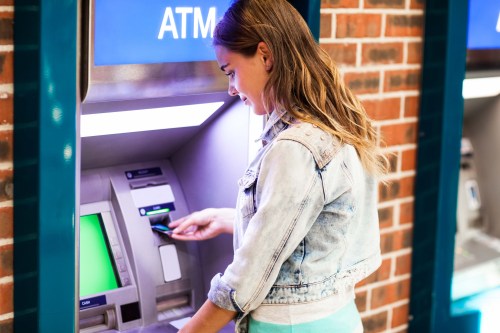Common Financial Literacy Terms for Kids

Parents, there’s no need to stress about relearning basic financial literacy terms to teach your kids. The terms we’ve listed below are words and concepts you probably know so well that you may not even realize they need explaining. But they do; as with everything else kids learn, knowing the basics will help your child build positive money-management skills. And the best way to teach common financial terms is by using language they’ll understand.
Think of it this way: When you overhear your teen talking about the latest TikTok trend, your eyes probably glaze right over. It’s just not a world you live in. It’s the same way for your kids when you try to explain financial literacy terms. Interest, what? Debt, huh? And what exactly is compound interest?
We’ve got you covered with this accessible guide to the financial terms and definitions you’ll need to start teaching your kids about saving, earning, and budgeting—skills that can help them now and in the future.
23 common financial literacy terms and definitions
Bank
Think of a bank as a big holding centre for money. It’s a place where individuals, households, businesses, and larger organizations can either deposit their funds or borrow money when they need to. Banks give out debit cards that allow people to access their money. They also lend money in the form of credit cards, car loans, mortgages, and personal loans. Banks also employ financial advisors who can sell investment products, like stocks, bonds, mutual funds, and foreign currencies.
Learn more about how to explain banking to your kids.
Borrow
Need to buy something important but don’t have the cash? That’s when you ask a bank or another lending institution if they can lend you what you need. There’s always an expectation that you’ll pay the money back, and the loan will come with conditions, which could include interest and late fees. You may also be asked if you have a form of security or collateral to cover the loan, like a house or a car.
Borrower
This is the person or organization (like a business) that’s receiving the loan.
Budget
A budget is a plan for spending and saving your money. Creating one helps you work toward your short-term savings goals, such as a limo for prom or a new pair of kicks. Creating a budget also helps you look at what you’re spending your money on and decide what can be reduced or cut completely.
Read more about budgeting for kids.
Capital gain
Capital property is something you own that’s considered valuable, like stocks or real estate. When your capital property is sold for more than it was originally purchased for, the money made on the sale is called a capital gain. On the other hand, if it’s sold for less than the original purchase price, it’s considered a capital loss.
Collateral
If you borrow money, collateral is something of high value offered to the lender just in case you can’t pay the money back. For example, a home loan (called a mortgage) uses a person’s home as collateral.
Credit
Credit is money given to you by a bank under the agreement that you’ll pay it back. Credit is different from a loan. While loans are given as a one-time lump sum with a set repayment schedule at generally lower interest rates, credit lets you access funds when you need them and borrowers only pay interest on the money they use. Managing credit responsibly means that you only spend what you know you can pay back every month.
Learn more about how to explain credit to your kids.
Credit score
Think of a credit score as your report card for how well you handle money and whether you pay your bills on time. It is generally represented by three numbers that are formulated by a credit bureau. Most credit scores range between 300 and 850, and the higher the score, the better. A high score tells a lender that you’ve repaid your debts on time in the past and can qualify for loans at lower interest rates. A low score means the borrower has struggled in the past with debt repayment and may be refused loans in the future or pay a higher interest rate on loans.
Learn more: How teens can build a credit score in Canada
Debit
Debit is just another way to say “subtract from.” Think of your debit card: You use it to subtract money from existing funds to make a payment or purchase. Purchases made on a debit account lower—or subtract from—the balance. Note that purchases on a credit account raise the balance, which represents the amount of money that needs to be repaid.
Learn more about debit cards for kids.

Donation
A donation is money or a gift given to help a charity or community organization. When you make a donation to a charity registered with the Canada Revenue Agency (CRA), it’s tax deductible, which means you can claim a portion of the amount back as a credit on your next income tax filing.
Learn more about the best way to teach kids about giving.
Emergency fund
This is money set aside for, well, emergencies—say you lose your job unexpectedly, your house gets flooded or someone gets sick. It’s generally recommended that adults have an emergency fund that can cover three to six months of living expenses like rent, food, and transportation. That way they can get the basic bills paid and keep food on the table until they recover. It’s also a great idea for teens and tweens to contribute to their own emergency funds for just-in-case spending. Setting aside some loose change or a few dollars in a savings account each month is a good way to start.
Read more: Emergency funds explained for teens.
Exchange rate
This is the value of one country’s currency compared to another’s, which can change daily. In Canada, we usually compare the loonie against the U.S. dollar. For example, if you’re going on a trip to NYC, checking the exchange rate will tell you how many Canadian dollars you’ll need to buy US$100.
A country’s exchange rate is either determined by what’s going on in the financial world (i.e., the global market) or set by the country itself. The Bank of Canada lets what’s happening in the global market set our exchange rate. This is also called allowing the dollar to “float.” It does this in order to maintain stable inflation rates year over year.
Fee
Banks and other financial institutions usually charge you for using their products and services, like using a bank account or making a special transaction, like transferring money to another country. How much they charge varies by institution. You may also be charged fees as a penalty for things like overdrawing funds on your debit account or taking money out of a different bank’s ATM.
Fixed expenses
Like that math quiz that happens every Friday, fixed expenses are bills that come at set intervals (once a week, biweekly, or monthly) and don’t generally change. Examples include rent, cellphone bills (not including long-distance or extra-data charges!), and car insurance.
Financial well-being
Financial well-being (also called “financial health“) means feeling secure about your money: You’re not sweating small splurges because you’re still able to afford your everyday needs, and you’re meeting short-term goals. If you can go grab a burger on Friday night and still be able to pay your phone bill and save a bit for the new hoodie you want, your financial well-being is on point.
Generational wealth
Money or valuable things that are passed down from your grandparents to your parents to you are called generational wealth. This can be in the form of college or university tuition, a house, the family business, or another type of inheritance. People with generational wealth have a head start on life when it comes to where they live and what they can afford, while people without it—often racialized people—may have to scrimp and save or take out loans to cover major expenses.
Income tax
This is money that goes from your paycheque, or any other earnings, to the government. Income taxes may seem like a drag, but your money goes toward keeping public schools free, libraries funded, youth social programs running, and cool government programs, like wildlife-conservation projects, afloat.
There’s no minimum age requirement to file income taxes—instead, you report your income when you start earning more than the basic personal tax exemption (for 2023, it was $15,000 in Canada). Most kids don’t reach this number until their later teen years.
Read more about how income taxes work in Canada.
Interest
Interest is the cost of borrowing money, which means you end up paying back more than you borrowed. Debts such as loans and credit cards have interest, which is paid by the person who borrowed the money. On the flip side, if you keep your money in a savings account, the bank will pay you interest for parking your funds in an account with them.
Interest generally falls under two categories. Simple interest is a fixed percentage on the initial amount of money loaned out (or “principal”). Compound interest is interest upon interest—it’s based on both the initial amount plus added interest earned on top. If you earn compound interest in a savings account, it kind of feels like free money. This is why it’s smart to start saving young. The earlier you start, the more compound interest grows that initial amount over time and the more money you can earn in the long run.
Learn more about how to explain interest to your kids.
Inflation
Think of a balloon: An inflated one contains more air than a deflated one, but it’s still the same balloon. So when the inflation rate is high, you need more and more money to buy the same (inflated) things. Put another way, inflation is the price increase of the things people buy over a period of time. The faster the rate of inflation, the fewer things people can afford, which isn’t great for the overall economy. To keep Canadians protected, the Bank of Canada usually targets a steady two per cent annual inflation rate. So if you buy, say, a sweet backlit gaming keyboard this year for $100, that same keyboard should cost no more than $102 to replace next year.
Read more about explaining inflation to kids and teens
Lender
This is either a person or a financial institution, such as a bank or credit union, that loans out money.
Loan
A loan is a set amount of money lent between people and institutions—usually banks—to pay for a large purchase that would otherwise be unaffordable up front (like a car or a house). In finance, loans come in two forms:
- Secured loan: Just like it sounds, this loan has built-in security just in case the borrower can’t pay it back. Usually high-value items, like a house or car, are used to secure this type of loan. If the borrower can’t make their payments, they could lose their house or car.
- Unsecured loan: This is money loaned out to someone who, based on factors such as income and credit score (see above), is likely to pay back their debts. While there’s no risk of losing your house or other high-value item, an unsecured loan may charge a higher interest rate.
Savings
Unlike an emergency fund (see above), savings are money set aside for the future or for a specific financial goal, like a big trip or tickets for BTS’s next world tour. When people start earning money, it’s recommended that they put aside some of their income for savings every month. Younger kids can get the idea by keeping a piggy bank and, as they get older, opening a bank account where they can sock away gift money (think: when a grandparent includes $20 in the birthday card) or whatever’s left over from their allowance.
Learn more about tips for teaching your kids to save money.
Wants vs. needs
Wants are spur-of-the-moment purchases or splurges. Like when you’re at the mall and you decide to buy that cool sweater in the window of your favourite store. Needs, on the other hand, are exactly that: things that you need, like textbooks and transit passes. Being able to distinguish between wants and needs helps you cut down on unnecessary spending and save more money.
Financial well-being looks different for everyone. Being able to understand basic money skills and give kids a little financial education, combined with Mydoh’s family-friendly and practical finance tools, can help lay the groundwork for raising money-smart kids.
Download Mydoh and help build a foundation of financial literacy for your kids and teenagers.
This article offers general information only and is not intended as legal, financial or other professional advice. A professional advisor should be consulted regarding your specific situation. While the information presented is believed to be factual and current, its accuracy is not guaranteed and it should not be regarded as a complete analysis of the subjects discussed. All expressions of opinion reflect the judgment of the author(s) as of the date of publication and are subject to change. No endorsement of any third parties or their advice, opinions, information, products or services is expressly given or implied by Royal Bank of Canada or its affiliates.















